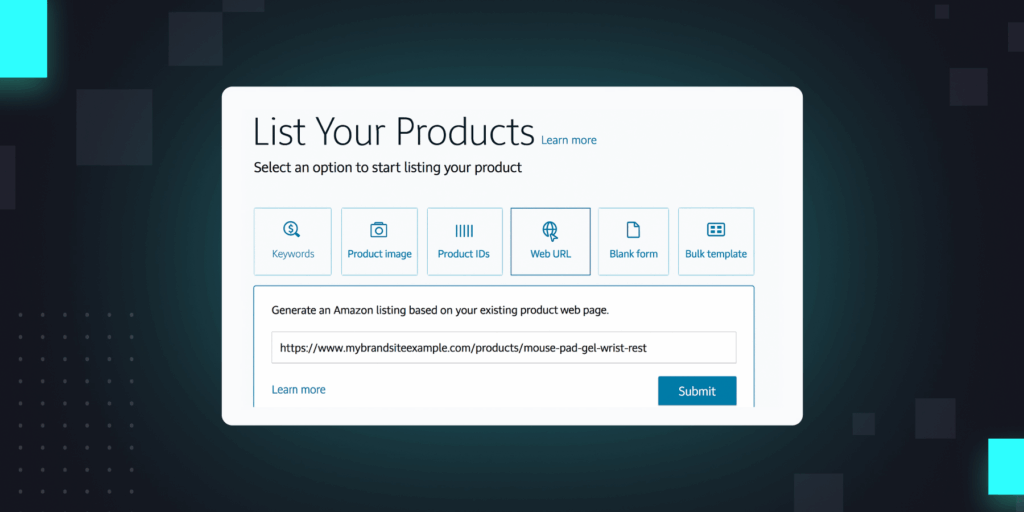We just got back from Amazon Accelerate, where we got to hear many of Amazon’s big announcements first hand. One announcement that stood out to us: Amazon is launching a generative AI tool that will write your product descriptions for you.
The new feature is called Generate Listing Content. It’s free, built into Seller Central, and easy to use.
Big news, right? If you’re feeling a bit of whiplash on all the recent Amazon AI news, don’t worry. It’s not just you. The new product content feature is one of several high-profile AI tools focused on product pages that Amazon has teased or debuted in recent months.
There’s been a lot of news happening at once, and it can be hard to track. So we wanted to take a step back, and evaluate where we’re at.
How popular are AI-generated product descriptions?
Let’s start with the recent product description news.
In the Generate Listing Content tool, sellers can write down a brief description of their product—say, “cast iron saucepan with lid.”
Then Amazon’s generative AI tool will suggest a title, product description, and key bullet points. Sellers can edit them as needed, then publish their listing.
Of course, AI-generated product descriptions are not necessarily new. Brands have been using AI tools like Jasper for years to help them write product descriptions at scale. Newer AI platforms like Writer also offer popular ways to generate product descriptions.
What’s new is just how accessible AI tools are about to become. Every Amazon seller is going to have generative AI at their fingerprints—and a lot of them will probably take advantage.
How do we know this? eBay.
This summer, eBay announced an AI product description tool that would, given a title and a product category, come up with an entire description for a seller. eBay has already had a lot of success—it recently said that about 30% of its U.S.-based sellers use the tool each day.
If similar numbers hold for Amazon, that would represent a huge shift on the look and feel of the platform.
The upside: For brands that sell a lot of products, AI-generated listings can be a big deal. With a good AI, you don’t need to take the time to write new descriptions for the hundreds, even thousands, of products in your catalog.
Plus: Even if you don’t have a giant catalog, AI can help if you’re looking for inspiration for your own descriptions.
The downside: Potentially, we will be entering an era of uniformity in product listings.
Sure, Amazon’s AI tools seem fully capable of creating solid, SEO-optimized content. A shopper probably won’t even notice that AI wrote the description.
But what happens if product descriptions on Amazon start to sound the same? In a crowded marketplace like Amazon, the name of the game is standing out. Too much AI-generated content might make this harder.
What’s next for Amazon’s AI?
For an idea of what’s to come, it might be useful to return to the example of eBay.
Just this past week, eBay launched another powerful AI listing tool—this time, focused on images. Upload an image into the eBay app, and eBay’s AI will automatically describe it for you. You can get an AI-generated title, description, and category and subcategory out of a single image.
It isn’t hard to imagine Amazon eventually rolling out something similar. Certainly, Amazon is already experimenting with AI for images. In May 2023, for example, The Information reported that the platform was building AI tools that could generate images and videos for advertising.
Amazon has yet to formally showcase this product. But a spokesperson confirmed it was coming.
All told: We might not be far off from fully automated creative assets for your product pages. Type in a brief outline of your product, and you might soon be able to receive not just product descriptions and titles, but also fully AI-generated images and videos for your PDP.
The AI features you probably can’t control
So far, the AI tools we’ve discussed are totally optional. Already happy with your descriptions and creative assets? You don’t have to use them.
That’s less true for Amazon’s other big recent rollout: AI-generated customer review highlights.
Amazon has begun using AI to write short descriptions that summarize the pros and cons of your product, based on the reviews. Essentially: If shoppers don’t want to read all the reviews, they can quickly see the key talking points through these review highlights.
Customers can also tap certain key talking points (such as “Performance” and “Ease of use”), and filter for the reviews that mention these phrases.
To avoid highlighting fake reviews, Amazon is focusing the AI tool only on trusted reviews from verified purchases.
But the newest tool makes some brands nervous. What if you feel the review highlights don’t accurately capture the sentiment on your page? So far, you don’t have a lot of recourse—other than to carefully track your reviews, and resolve any issues that come up.
We have a feeling Amazon isn’t going to stop there. Don’t forget, Amazon CEO Andy Jassy said in the most recent earnings call that “every one of our teams is working on building generative AI applications.”
We’re only just starting to see the evidence.
(Want to read more content like this? Be sure to subscribe to our newsletter.)







